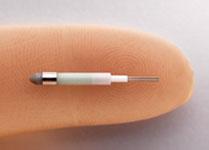
The Axxent HDR X-ray Source delivers high dose rate, low energy radiation treatment without the use of radioactive isotopes.
June 16, 2010 – New research continues to support the benefits of isotope-free electronic radiation therapy delivered directly to cancer sites with minimal exposure to surrounding healthy tissue.
The most recent publication is four-year data from the TARGIT-A (Targeted Intraoperative Radiation Therapy) multicenter clinical trial presented this week at the 46th Annual American Society of Clinical Oncology Meeting and published in the current issue of the Lancet. The TARGIT-A Trial is a randomized controlled trial designed to assess the equivalency of intraoperative radiotherapy (IORT) with a single dose against standard three- to six-week external beam radiotherapy after breast-conserving surgery in women 45 years and over with invasive ductal carcinoma.
Results from the study "Twelve-Month Follow-Up Results of a Trial Utilizing Xoft Axxent Electronic Brachytherapy to Deliver Intraoperative Radiation Therapy for the Early Stage Breast Cancer" were also presented recently at the American Society of Breast Surgeons by Olga Ivanov, M.D., breast surgeon and medical director for Little Company of Mary's Comprehensive Breast Health Center. The 12-month results suggest that IORT utilizing Xoft's Electronic Brachytherapy is emerging as a novel, patient- and physician-friendly alternative to Whole Radiation Therapy (WBRT) as well as Accelerated Partial Breast Irradiation (APBI) in a selected group of patients with early breast cancer. At a mean follow-up of 12 months, overall results were encouraging with excellent scores achieved in cosmesis and patient satisfaction. While long-term follow-up will continue, no recurrences have been observed to date.
"I believe that giving a single fraction of radiation at the time of surgery is advantageous because it allows all the radiation to be delivered before any remaining tumor cells have a chance to grow and intensifies the dose to the part of the breast at highest risk for recurrence," said Adam Dickler, M.D., radiation oncologist at Little Company of Mary Hospital. "Additionally, by working in concert to deliver IORT treatment, breast surgeons and radiation oncologists may be better able to decrease the number of patients who decide to be treated with surgery alone despite the fact that radiation has been shown to be an essential component of treatment and increases overall survival."
IORT is a technique where a concentrated dose of radiation is delivered to a cancerous tumor site during surgery after the tumor is removed. Because the target and normal tissues can be clearly identified during surgery, IORT may increase targeting accuracy, thereby increasing dose to the target and reducing dose to critical structures. For breast IORT, the shorter treatment time is generally more convenient for patients than the seven-week course of external beam-therapy, and may increase patient compliance.


 December 04, 2025
December 04, 2025 








